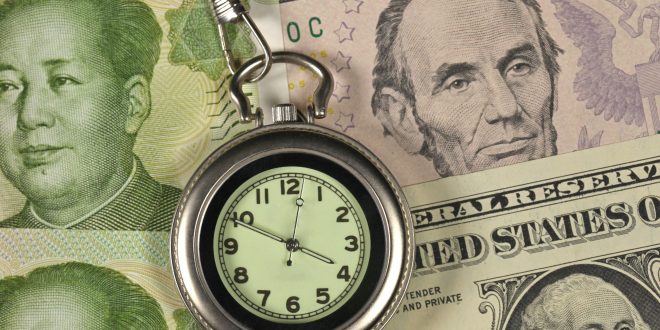The past week was full of events, the week began with a public holiday in the United States on Independence Day, and then the events started to follow. Take a comprehensive look at this weekly report.
Wall Street
The three major US stock indexes rose to unprecedented levels at the close on Friday, as shares in the financial sector and other sectors related to the economy rebounded after a sell-off sparked by growth fears earlier in the week.
The financial sector shares on Standard & Poor’s led the sector’s gains, followed by energy, raw materials, and industrial shares.
The Dow Jones Industrial Average rose 446.29 points, or 1.3 percent, to 34,868.22 points, the S&P 500 closed up 48.44 points, or 1.12 percent, to 4,369.26 points, and the Nasdaq Composite Index increased 139.83 points, or 0.96 percent, to 14,699.61 points.
EUR/USD
On Friday evening, the EUR/USD pair halted its 2-day recovery as the US dollar saw some rebound thanks to the London fix. But despite the pullback, the currency pair held much of its gains, flat above the 1.1850 level, after hitting a two-day high of 1.1875 on Friday evening.
Markets continue to undermine safe-haven demand providing some support. The pair rebounded from a 3-month low of 1.1782 on Thursday after the European Central Bank adopted a symmetric 2% inflation target at its strategy review meeting.
Gold
Gold rose in volatile trading on Friday, July 9, boosted by concerns about the fast-spreading delta variant of Covid-19 and a drop in US Treasury yields.
Gold futures fell to $ 1807 an ounce, compared to the closing recorded in the previous session at $1802 an ounce.
The precious metal rose to its highest level in the current session at 1812 dollars, compared to its lowest level in the same period at 1796 dollars.
The benchmark 10-year US Treasury yields fell to near the lowest level in more than four months, while the US dollar rose 0.1% towards its highest level in three months, recorded in the previous session.
Sentiment remains fragile in the broader stock markets as the delta strain threatens the global economic recovery, pushing Asian stocks to a two-month low.
The minutes of the US Federal Reserve’s June policy meeting, released Wednesday, revealed that while economic recovery is “generally not yet achieved”, Fed officials agreed they should be prepared to act if inflation picks up or other risks materialize.
The precious metal is under pressure from concerns about an imminent tightening of monetary policy by the US Federal Reserve, which pushed gold to decline 7% in June.
EIA
The US Energy Information Administration (EIA) announced that it lowered its forecast for 2021 world oil demand growth by 80,000 barrels per day (bpd) to an annual increase of 5.33 million bpd, as reported by Reuters.
On the other side, the EIA also noted that it raised the forecast for 2022 world oil demand growth by 80,000 bpd to 3.72 million bpd.
US and China
On Sunday, China’s Ministry of Commerce “strongly opposes” the addition of 23 Chinese entities to the US economic black-list over issues including alleged human rights abuses and military ties. In a statement, a ministry spokesman said the listing of Chinese entities was a “serious violation of international trade and economic rules” and “unreasonable suppression” of Chinese companies.
The statement added that the Chinese government “will take necessary measures to protect the legitimate rights and interests of China.”
The US Commerce Department said on Friday that it had added 14 companies and entities to its economic blacklist.
Fed Meeting
Federal Reserve members agreed that indicators of economic activity and employment are showing more strength in the recent period, according to the results of the Federal Reserve meeting.
More lasting but likely still temporary upward pressure on inflation has come from prices for goods experiencing supply chain bottlenecks.
Survey-based and market-based measures of longer-term inflation expectations have risen since the end of last year.
Inflation expectations in a range that is broadly consistent with the longer-run inflation objectives.
Fed institutions at the core of the financial system remain resilient.
Fed’s CIE index at levels ‘likely more consistent’ with fed’s longer-term 2% inflation goal.
Calendar
There were several PMIs at the start of the week.
The economic activity in the US service sector continued to expand in June, albeit at a softer pace than it did in May, with the Institute for Supply Management (ISM) Services PMI declining to 60.1 from 64. This reading missed the market expectation of 63.5.
The seasonally adjusted IHS Markit/CIPS UK Services Purchasing Managers’ Index (PMI) was revised higher to 62.4 in June versus 61.7 expected and a 61.7 – last month’s flash reading.
In the UK, Manufacturing output arrived at -0.1% MoM in May versus 1.0% expectations and 0% booked in April while total industrial output came in at 0.8% vs. 1.5% expected and -1.0% last.On an annualized basis, the UK manufacturing production figures came in at 27.7% in May, missing expectations of 29.5%.
Germany’s industrial production unexpectedly fell in May as Eurozone’s economic powerhouse’s industrial output dropped by 0.3% MoM. The federal statistics authority Destatis said in figures adjusted for seasonal and calendar effects, vs. a 0.5% rise expected -1.0% last.
On the other side of the ocean, there were 373,000 initial claims for unemployment benefits in the US during the week ending July 2, the data published by the US Department of Labor (DOL) revealed on Thursday. This reading more than the market expectation for a reading of 350,000 and followed last week’s upwardly revised reading of 371,000
China’s Caixin services PMI for June came in at 50.3 vs. 55.7 expected and 55.1 last, showing a sharp slowdown in the country’s services activity in the reported month.
Coronavirus
On Sunday, Australia recorded the first death linked to the Coronavirus this year, in addition to recording a record number of infections during 2021, which amounted to 77 new cases of the virus in the state of New South Wales, which is fighting the outbreak of the Delta strain of the virus.
State Premier Gladys Berejiklian said the numbers were expected to rise further in the coming days in Sydney and its surrounding areas, which are subject to a three-week lockdown.
“We just want people to stay home. The virus won’t spread if people don’t leave home,” said Gladys Berejiklian, NSW premier.
On Saturday, Australia recorded 50 cases, the previous record for 2021. This brings the number of recent outbreaks to 566.
Among the cases on Sunday, 26 people came into contact with people while they were infected, which deepened fears of extending general isolation to more than five million people in Sydney and its surrounding areas.
 Noor Trends News, Technical Analysis, Educational Tools and Recommendations
Noor Trends News, Technical Analysis, Educational Tools and Recommendations





